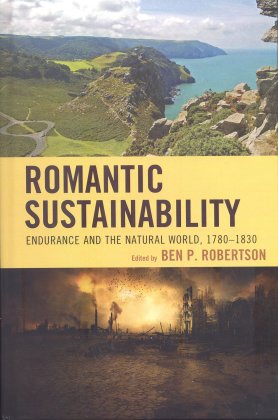  Robertson, Ben P., ed. Romantic Sustainability: Endurance and the Natural World, 1780-1830. Lanham, MD: Lexington Press, 2016.
Robertson, Ben P., ed. Romantic Sustainability: Endurance and the Natural World, 1780-1830. Lanham, MD: Lexington Press, 2016.
Romantic Sustainability is a collection of sixteen essays that examine the British Romantic era in ecocritical terms. Written by scholars from five continents, this international collection addresses the works of traditional Romantic writers such as John Keats, Percy Shelley, William Wordsworth, Lord Byron, and Samuel Coleridge but also delves into ecocritical topics related to authors added to the canon more recently, such as Elizabeth Inchbald and John Clare. The essays examine geological formations, clouds, and landscapes as well as the posthuman and the monstrous. The essays are grouped into rough categories that start with inspiration and the imagination before moving to the varied types of consumption associated with human interaction with the natural world. Subsequent essays in the volume focus on environmental destruction, monstrous creations, and apocalypse. The common theme is sustainability, as each contributor examines Romantic ideas that intersect with ecocriticism and relates literary works to questions about race, gender, religion, and identity.
Contents
List of Illustrations
Abbreviations
Introduction by Ben P. Robertson
Part I: Inspiration and the Imagination
Chapter 1: "Coleridge’s 'Deep Romantic Chasm': Kubla Khan, the Valley of Rocks, and the Geomorphological Imagination" by Adrian J. Wallbank
Chapter 2: "Strict Machine: The DILLIAM Eco-Loop" by Michael Angelo Tata
Chapter 3: "Romantic Clouds: Climate, Affect, Hyperobjects" by Seth T. Reno
Chapter 4: “'In Some Untrodden Region of My Mind': Mental Landscapes in Keats’s Poetry" by Huey-fen Fay Yao
Part II: Diets and Consumption
Chapter 5: "Sublime Diets: Percy Shelley’s Radical Consumption" by Madison Percy Jones
Chapter 6: "The Bloodless Church: Dualist Asceticism and Romantic Vegetarianism" by Emily Paterson-Morgan
Chapter 7: "The Horror of Starvation: Sustainability in Allan Cunningham’s and John Francis Campbell’s Supernatural Tales" by Fernando Gabriel Pagnoni Berns
Part III: Alienation and Environmental Degradation
Chapter 8: "First Child in the Woods: 'Nature-Deficit Disorder' and the Future of Romantic Childhood" by William Stroup
Chapter 9: “'The Temple of Folly': Transatlantic 'Nature,' Nabobs, and Environmental Degradation in The Woman of Colour" by Denys Van Renen
Chapter 10: "A Pauper’s Sustenance: Malthusianism and John Clare’s 'The Lament of Swordy Well'” by Kultej Dhariwal
Part IV: Beasts and Monsters
Chapter 11: "Masculinity, Monstrosity, and Sustainability in Mary Shelley’s Frankenstein" by Avishek Parui
Chapter 12: "The Monsters of Zocotora: Negotiating a Sustainable Identity through the Environment in Elizabeth Inchbald’s Nature and Art" by Ben P. Robertson
Chapter 13: "Wollstonecraft—Unnatural Woman: Between the Nature of the Feminine and a Gendered Nature" by Molly Hall
Part V: Extinction and Apocalypse
Chapter 14: "Shelley and the Limits of Sustainability" by Adam R. Rosenthal
Chapter 15: "Apocalypse Not Quite: Romanticism and the Post-Human World" by Olivia Murphy
Chapter 16: "Questioning Agency: Dehumanizing Sustainability in Mary Shelley’s The Last Man by Lauren Cameron
About the Contributors
Index
|

 Robertson, Ben P., ed. Romantic Sustainability: Endurance and the Natural World, 1780-1830. Lanham, MD: Lexington Press, 2016.
Robertson, Ben P., ed. Romantic Sustainability: Endurance and the Natural World, 1780-1830. Lanham, MD: Lexington Press, 2016.